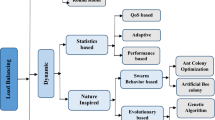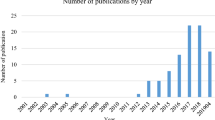Abstract
Excessive intercell trips in a cellular manufacturing system may minimize the benefits that the system can provide. Hence, this research develops a non-linear integer formula to reduce intercell trips in a cell type system design. A clustering algorithm is then developed to obtain a satisfactory solution to the proposed cell formulation problem. To determine the performance of the proposed clustering algorithm, comparisons are made with an Exhaustive Search (ES) algorithm to show the relative optimality.
Similar content being viewed by others
References
Burbidge J.L. (1977) A manual method for production flow analysis. Production Engineer, 56: 34
Baykssoglu A., Gindy N. (2000) MOCACEF 1.0: multiple objective capability based approach to form part-machine groups for cellular manufacturing application. International Journal of Production Research 38(5): 1133–1161
Caux C., Bruniaux R., Pierreval H. (2000) Cell formation with alternative process plans and machine capacity constraints: a new combined approach. International Journal of Production Economics 64(1–3): 279–284
Chandrasekharan M.P., Rajagopalan R. (1986a) MODROC: an extension of rank order clustering for group technology. International Journal of Production Research 24(5): 1221–1233
Chandrasekharan M. P., Rajagopalan R. (1986b) An ideal seed non-hierarchical clustering algorithm for cellular manufacturing. International Journal of Production Research 24(2): 451–464
Chen W.H., Srivastave B. (1994) Simulated annealing procedures for forming machine cells in group technology. European Journal of Operation Research 75: 100–111
Hwang H., Sun J. (1996) A genetic-algorithm-based heuristic for the GT cell formation problem. Computers and Industrial Engineering 30(4): 941–955
Harhalakis G., Nagi R., Proth J.M. (1987) An efficient heuristic in manufacturing cell formation for group technology applications. International Journal of Production Research 25(5): 639–665
Hyer N.L., Wemmerlov U. (1982) MRP/GT: a framework for production planning and control of cellular manufacturing. Decision Sciences 13: 681–701
Hyer N. L., Wemmerlov U. (1987) Research issues in cellular manufacturing. International Journal of Production Research 25(3): 413–431
Hyer N. L., Wemmerlov U. (1989a) Cellular manufacturing in the U.S. industry: a survey of users. International Journal of Production Research 27(9): 1511–1530
Hyer N.L., Wemmerlov U. (1989b) Group technology in the US manufacturing industry: A survey of current practices. International Journal of Production Research 27(8): 1287–1304
King J.R. (1980) Machine-component grouping in production flow analysis: an approach using a rank order clustering algorithm. International Journal of Production Research 18(2): 213–232
King J.R., Nakornchai V. (1982) Machine-component group formation in group technology: review and extension. International Journal of Production Research 20(2): 117–133
Kusiak A. (1987) The generalized group technology concept. International Journal of Production Research 25(4): 561–569
Kusiak A., Chow W.S. (1988). Decomposition of manufacturing systems. IEEE Journal of Robotics and Automation 4(5): 457–471
Lee M.K., Luong H.S., Abhary K. (1997) A genetic algorithm based cell design considering alternative routings. Computer Intergrated Manufacturing Systems 10(2): 93–107
Leung Y. (1988). Spatial analysis and planning under imprecision. Elsevier Science Pub. Co, New York
Mahesh O., Srinivasan G. (2002) Incremental cell formation considering alternative machines. International Journal of Production Research 40(14): 3291–3310
McAuley J. (1972) Machine grouping for efficient production. Production Engineer 51: 53–57
Rajamani D., Singh N., Aneja Y.P. (1990) Integrated design of cellular manufacturing systems in the presence of alternative process plans. International Journal of Production Research 28(8): 1541–1554
Shtub A. (1989) Modeling group technology cell formation as a generalized assignment problem. International Journal of Production Research 27(5): 775–782
Singh N. (1993) Design of cellular manufacturing systems: An invited review. European Journal of Operation Research 69: 284–229
Srinivasan G., Narendran T.T., Mahadevan B. (1990) An Assignment model for part-families problem in group technology. International Journal of Production Research 28: 145–152
Song S., Hitomi K. (1992) GT cell formation for minimizing the intercell parts flow. International Journal of Production Research 30(12): 2737–2753
Stanfel L.E. (1989) A successive approximations method for a cellular manufacturing problem. Annals of Operations Research 17: 13–30
Vakharia A.J., Wemmerlov U. (1990) Designing a cellular manufacturing systems: a materials flows approach based on operation sequence. IIE Transactions 22(1): 84–97
Vannell A., Kumar K. (1992) A method for finding minimal bottle-neck cells for grouping part-machine families, International. Journal of Production Research 24(2): 387–400
Vivekanand P., Narendran T.T. (1998) Logical cell formation in FMS, using flexibility-based criteria. International Journal of Flexible manufacturing systems 10: 163–181
Author information
Authors and Affiliations
Corresponding author
Rights and permissions
About this article
Cite this article
Wei, NC., Mejabi, O.O. A clustering approach for minimizing intercell trips in cell formation. J Intell Manuf 19, 13–20 (2008). https://doi.org/10.1007/s10845-007-0042-8
Received:
Accepted:
Published:
Issue Date:
DOI: https://doi.org/10.1007/s10845-007-0042-8




